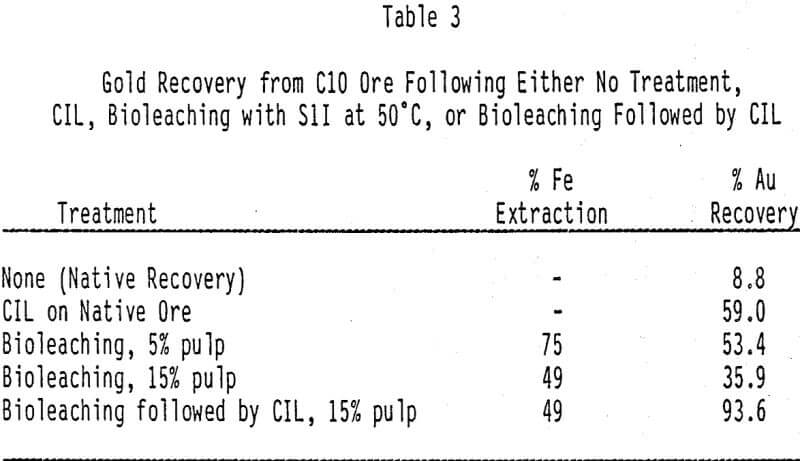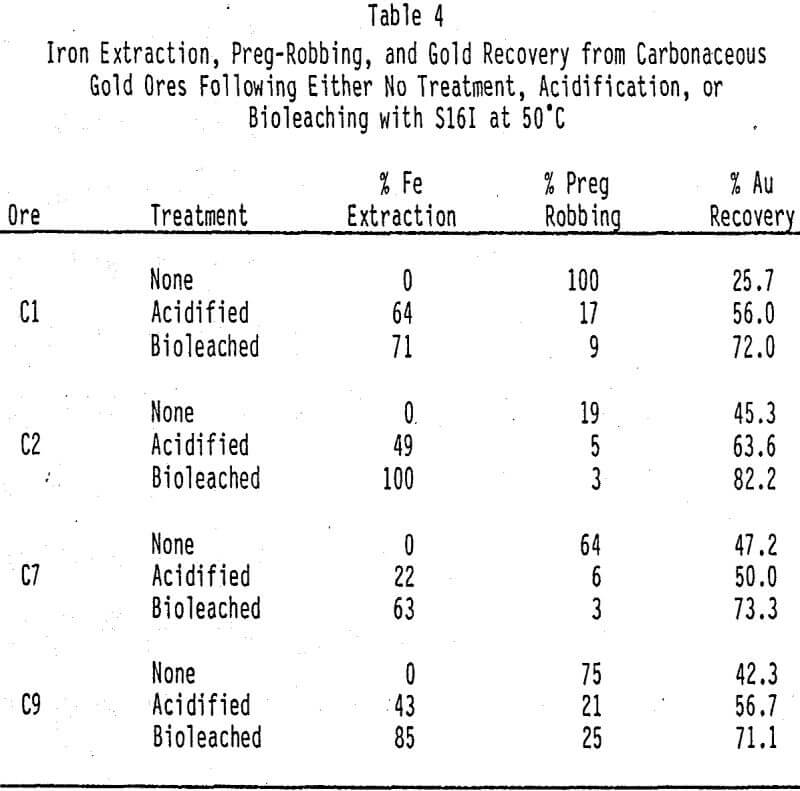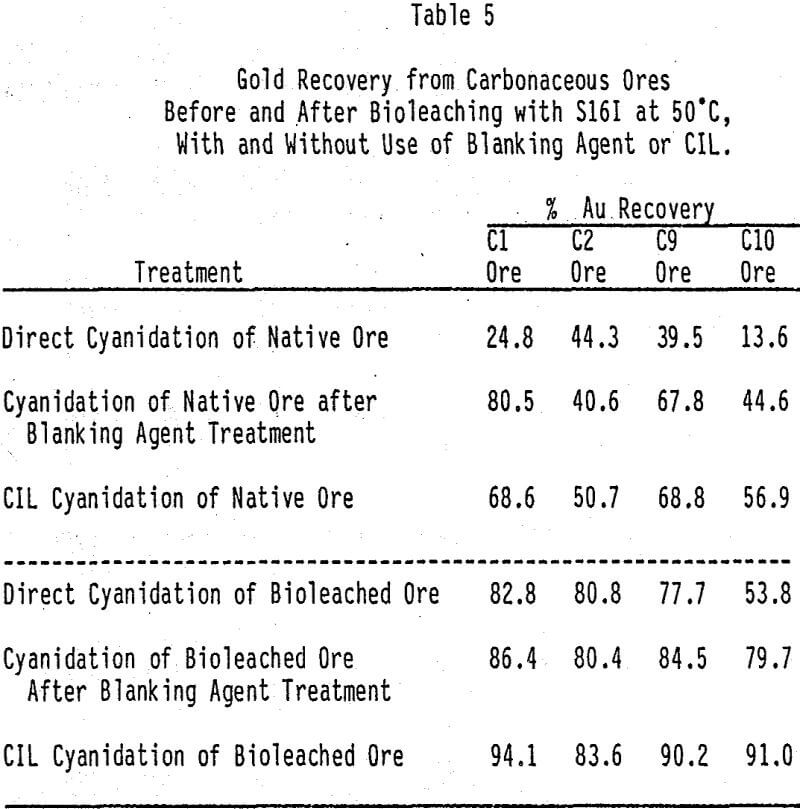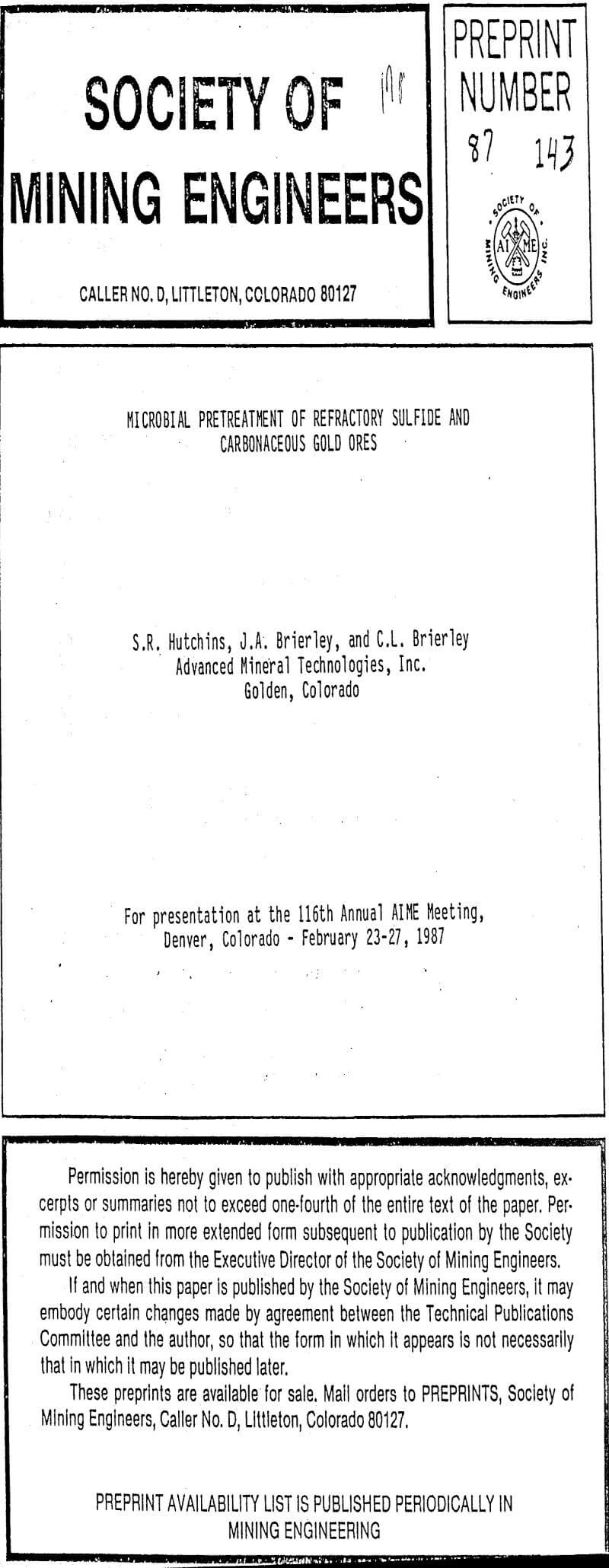Table of Contents
The previous tests demonstrated the use of facultative and extreme thermophiles for refractory sulfide gold ores and flotation concentrates. The following tests were conducted on carbonaceous gold ores to evaluate response to bioleaching.
Facultative Thermophile Bioleaching of Carbonaceous Gold Ore
The facultative thermophile S1I was used to pretreat a carbonaceous gold ore under CSTR conditions. This ore is very active, i.e., has a high preg-robbing potential. It contains approximately 1% marcasite and has a head grade of 13.1 mg/kg gold. Pulps were prepared in mineral salts media at either 5% or 15% pulp density and adjusted to pH 1.6-1.7 with sulfuric acid. Samples were inoculated with starter cultures containing S1I and incubated at 50°C.
Because the ore only contained 2% iron, it was leached fairly rapidly; in two days, 50% of the iron was extracted in the 15% pulp and 75% of the iron was extracted in the 5% pulp (Table 3). For the 15% pulp, gold recovery was increased from 8.8% to only 35.9% following bioleaching with the facultative thermophile. However, when the bioleached residue was cyanided in the presence of activated carbon (CIL), gold recovery increased to 93.6%. This indicates that bioleaching had little effect on the preg-robbing characteristics of the ore. Treatment of the native ore by CIL increased

gold recovery to only 59.0%, demonstrating that both bioleaching and CIL are required to obtain high gold recoveries from this ore. Because greater iron extraction was achieved from the ore which was bioleached at 5% pulp density, it is likely that CIL-cyanidation would have yielded higher gold recovery from this material; this was not tested because there was insufficient material available. For this ore, then, bioleaching with facultative thermophiles produces a residue which allows greater gold recovery by cyanidation, but CIL is also required to achieve satisfactory yields of precious metal.
Microbial Inhibition of Preg Robbing
As seen in the previous example, the carbonaceous gold ore was still active with respect to preg-robbing even after bioleaching. Four other carbonaceous gold ores were tested to determine how bioleaching affected the preg-robbing potential. Pulps of each ore were prepared at 10% pulp density in mineral salts media and acidified to pH 1.6-1.7 with sulfuric acid. Samples were taken at this time to determine the effect of acidification without bioleaching. The remaining samples were inoculated with the facultative thermophile S16I and incubated in Fernbach flasks at 50°C. Bioleached residues and acidified residues were evaluated for iron extraction and for gold recovery by cyanidation. In addition, the residues were subjected to preg-rob analysis to determine the activity of the treated materials.
For each ore, acidification to pH 1.6-1.7 resulted in significant iron extraction and a substantial drop in preg-robbing potential (Table 4). This

generally led to increased gold recovery relative to the native ore, although the increase was not significant in the case of the C7 ore. After the acidified ore was bioleached with S16I, iron extraction had increased substantially. In contrast, there was only a slight decrease in preg-robbing potential for most of the ores (Table 4). This again indicates that bioleaching had little effect on the activity of the carbonaceous gold ores. However, gold recovery substantially increased in all cases, demonstrating that bioleaching yielded an alternate beneficial effect, presumably through liberation of gold encapsulated in iron sulfide minerals. Gold recoveries ranged from 71-82% from the bioleached residues compared to 26-47% from the native ore. Although in most cases little preg-robbing activity remained in the bioleached residues, it is likely that deactivating steps such as CIL would have yielded higher gold recoveries. This was tested during cyanidation of the C7 carbonaceous gold ore sample; gold recovery from the bioleached residue was increased from 73.3% to 98.0% using CIL during cyanidation.
Bioleaching, CIL, and Blanking Agent
Four carbonaceous gold ores were tested to determine the relative merits of using bioleaching, CIL, or a blanking agent to enhance gold recovery. Pulps of each ore were prepared at 10% pulp density in mineral salts media and acidified to pH 1.4-1.6 with sulfuric acid. The samples were inoculated with starter cultures of the facultative thermophile S16I on the respective ore and were incubated in 250-ml flasks at 50°C. The native ore and the bioleached samples were subjected to one of three recovery processes: (1) direct cyanidation, (2) CIL cyanidation, and (3) direct cyanidation following pretreatment with, a proprietary blanking agent. Pretreatment with the blanking agent consisted of acidifying the pulp to pH 1.4-1.6 with sulfuric acid and adding the blanking agent to the pulp. The pulps were mixed for 20-24 hr at 50°C and then filtered. The residue was neutralized and was extracted directly with cyanide as described. For the bioleached samples, treatment with the blanking agent took place after bioleaching was complete.
Gold recoveries from the native ores were generally enhanced following deactivation of the organic matter with the blanking agent (Table 5). Part of the enhanced response may have been due to solubilization of iron sulfide minerals in the acidified pulps undergoing blanking agent treatment. As an alternative, CIL cyanidation of the carbonaceous gold ores also improved gold recovery to either a greater or lesser extent than the blanking agent pretreatment, depending on the ore (Table 5). In general, bioleaching the carbonaceous ores produced residues which yielded better gold recoveries than either CIL or blanking agent pretreatment. However, gold recoveries were still rather low and in the 54-83% range. Combining bioleaching with either deactivating method yielded substantially improved gold recoveries for all but the least active C2 ore (Table 5). The effect was especially apparent for the highly active CIO ore. Unlike the case with the native material, CIL was more effective than blanking agent pretreatment for each of the bioleached residues. Cyaniding the bioleached residues using CIL yielded gold recoveries in the 84-94% range.


